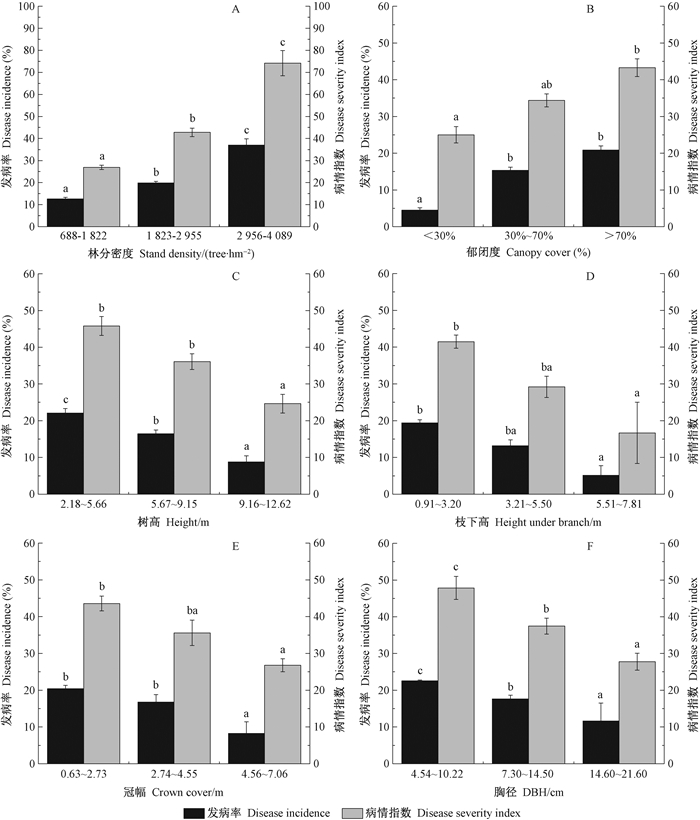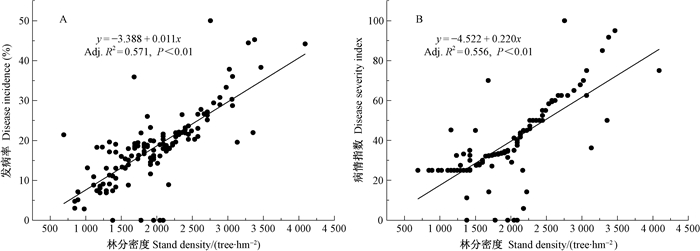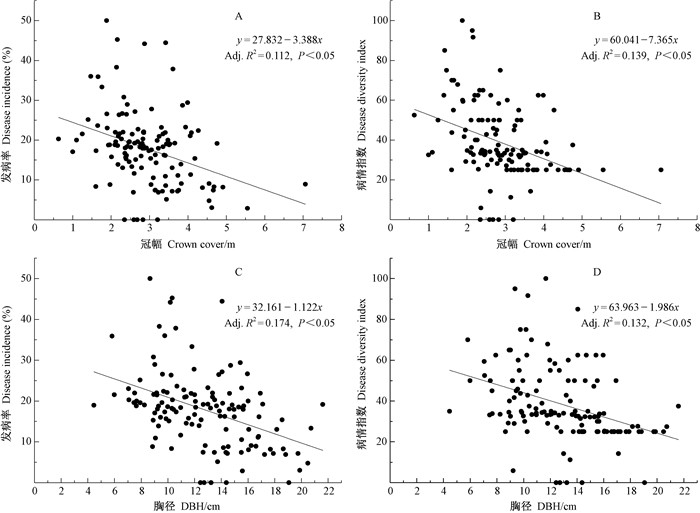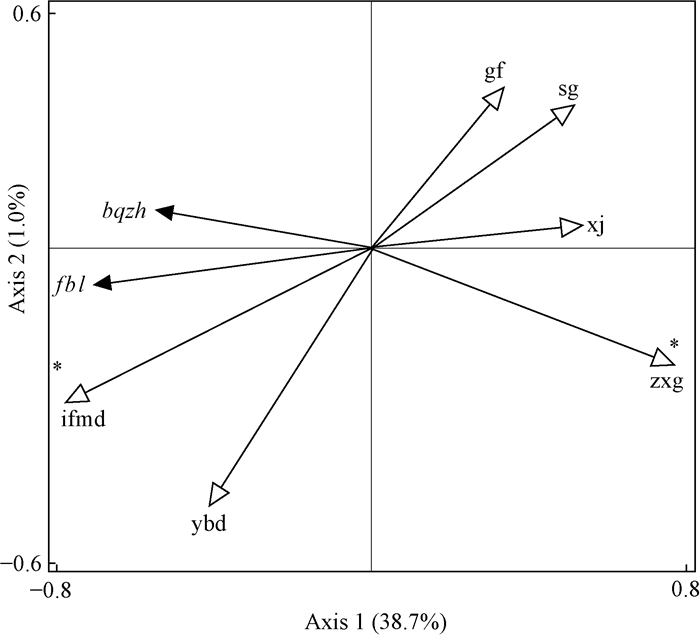文章信息
- 胡瑞瑞, 梁军, 谢宪, 黄咏槐, 王俊, 苑晓雯, 张英军, 张星耀.
- Hu Ruirui, Liang Jun, Xie Xian, Huang Yonghuai, Wang Jun, Yuan Xiaowen, Zhang Yingjun, Zhang Xingyao.
- 昆嵛山赤松纯林赤枯病特征及与林分因子的关系
- The Characteristics of Needle Blight of Pure Pinus densiflora Forests in Kunyushan Mountains and Its Relationship with Forest Factors
- 林业科学, 2019, 55(7): 95-104.
- Scientia Silvae Sinicae, 2019, 55(7): 95-104.
- DOI: 10.11707/j.1001-7488.20190710
-
文章历史
- 收稿日期:2018-05-31
- 修回日期:2018-12-19
-
作者相关文章
2. 昆嵛山森林生态系统定位研究站 烟台 264100
2. Kunyushan Forest Ecosystem Research Station Shandong Province Yantai 264100
在山东半岛东部的昆嵛山区,分布着我国面积最大的天然赤松(Pinus densiflora)林,赤松纯林面积约占该区森林总面积的70%,在保持水土、涵养水源、净化空气等方面发挥着重要的生态功能。然而长期以来,当地赤松林频繁遭受松赤枯病(Pestalotiopsis funerea)的威胁,大量赤松的针叶受害。赤枯病主要危害松树新叶,使叶子上出现坏死斑(Sousa et al., 2004; Orlikowski et al., 2014);发病严重时2年生针叶也会受害,并引起枯梢,甚至影响生态系统的稳定性(Li et al., 2012; 梁军等, 2016)。因此,及时开展对当地松赤枯病的调控机制和防治措施是一项紧迫的研究任务。
各项林分因子内部之间关系复杂,同时与叶部病害的发生关系密切,如林冠结构对孢子的传播有重要影响(Boudreau, 2013)。Vidal等(2017)认为浓密的冠层下叶子能较长时间保持湿润,所以更有利于病原物在这种条件下存活、扩散;且与纯林相比,具有较高树高的混合林,其病害发生严重程度急剧下降。Deltour等(2017)也提出类似观点,即植物群落结构组成对香蕉枯萎病(Fusarium oxysporum)有很高的抑制程度。Shi等(2007)研究发现, 具有较小胸径和平均冠幅的马尾松(Pinus massoniana)更易感染松材线虫(Bursaphelenchus xylophilus)病。此外,调控林地林分因子作为一种预防性措施,能使病原物与寄主植物处在一种“准平衡”状态中(梁军等, 2005),或提高整个林木的活力和对病原物的抵抗力(Ameztegui et al., 2017)。所以,冷连基(1984)、叶建仁等(2006)对林分因子与叶部病害的关系作出深入研究,还将二者间的关系建立方程进行预测,以此指导营林实践工作。
笔者课题组已探明林分特征(孙志强等, 2010)、树种组成(朱彦鹏等, 2013)和物种联结性(潘琪等, 2014; 2015)与昆嵛山特有害虫——昆嵛山腮扁叶蜂(Cephalcia kunyushanica)的互作关系,并提出了有效的干预和调控措施。但对病害的研究尚不全面,只从松赤枯病对空间结构的响应进行过报道。如梁军等(2016)在麻栎(Quercus acutissima) -赤松混交林中,以赤松、黑松(Pinus thunbergii)和多脂松(Pinus resionosa)多个树种为研究对象,分析了空间结构指标(大小比数、角尺度和混交度)对赤枯病发生程度的影响,指出不同寄主的抗病能力不同,应根据寄主的不同空间结构指标与各树种赤枯病发生程度之间的关系,合理进行森林培育与经营。松赤枯病病原菌以分生孢子和菌丝体在寄主植物的枯黄病叶和落地病叶中越冬(王忠民等, 2014),寄主林木的不同种类、不同年龄、不同形态结构使其对赤枯病病害具有不同的感受性,林木的健康状况直接决定病害的发生程度(梁宏胜, 2004; 陈宝林等, 2008; 梁军等, 2016),说明松赤枯病是一种寄主主导型病害。因此,可以通过改善寄主植物健康而提高其对病原物的抵抗力(Ameztegui et al., 2017),继而实现从根源上控制病害。邱德勋等(1980)指出温、湿度不适可使马尾松因蒸腾作用加速或过度而降低其对赤枯病的抗性。梁宏胜等(2008)研究在陕西引种的奥地利黑松时发现,苗期对赤枯病具有很强的抗性,且该抗性主要因为其自身特有的结构:整齐、致密的表皮细胞和较小的气孔。
本研究在昆嵛山选取林龄相对一致、林相整齐的赤松纯林,设立样地;通过在大量样地调查、分析林分因子(林分密度、郁闭度、胸径等)与赤枯病发病率、病情指数的关系,定量评价林分因子对赤枯病的影响,并通过冗余分析对林分因子排序和筛选关键因子,以期为昆嵛山赤枯病的预防和控制提供理论指导。
1 研究区概况与研究方法 1.1 研究区概况昆嵛山(121°41′34″—121°48′04″E,37°11′50″—37°17′22″N)位于山东半岛东部,跨烟台昆嵛区和威海文登市。该区域受暖温带季风气候影响,气候温和,年均气温12.3 ℃,年降水量为800~1 200 mm,年均相对湿度62.6%,无霜期200~220天。土壤多为棕壤,且大部分为沙质壤土。森林类型有赤松林、黑松林、日本落叶松(Larix kaempferi)/杉木(Cunninghamia lanceolata)林、针叶树-麻栎林、针叶树-杂木林和阔叶林6种。赤松林作为昆嵛山的主要建群种,从山麓至海拔800 m均有分布。赤松主要受松赤枯病、枯梢病(Sphaeropsis sapinea)和松材线虫等病原物侵染和昆嵛山腮扁叶蜂、松毛虫(Dendrolinmus spectabilis)和松干蚧(Matsucoccus matsumurae)等害虫为害。
1.2 研究方法 1.2.1 样地设置依据昆嵛山二类森林资源调查数据提供的信息,小组于2017年5—8月进行样地的选取并展开调查工作。选取林龄相对一致(约34年)、林相整齐、空间分布均匀的赤松纯林,设立121块临时调查样地(30 m × 30 m),各林分因子的特征如表 1。
|
|
赤松林木的发病率采用踏查法进行调查,记录样地内赤松总株数和患病树木株数,病情指数采用“五点法”,即在每块样地内的4个角及中心各取2株,共10株赤松进行调查,然后对10株的株病情指数平均获得。对单株赤松样木分上、中、下3层,东、南、西、北4个方向用高枝剪各取1枝枝条,统计每枝的发病情况。将每个样本枝条的针叶视为底面积近似相同的圆柱形,所以每枝针叶的病斑面积与针叶面积比可转化为二者的长度之比。实测各枝条针叶病斑长度占针叶长度的比例,按五级分级加权平均数法对株病情指数进行计算,枝条病害分级标准见表 2。发病率和病情指数计算公式如下:
|
|
| $ 发病率 = \frac{{染病株数}}{{总株数}} \times 100\%; $ | (1) |
| $ 枝条针叶病斑面积比\%= \frac{{∑针叶病斑长度}}{{∑针叶长度}} \times 100\%; $ | (2) |
| $ 株病情指数=\frac{{\mathop \sum \limits_{i = 1}^{12} (病级枝条数×该病级代表值)}}{{总枝条数×最高病级代表值}} \times 100\%; $ | (3) |
| $ 林分病情指数=\frac{{\mathop \sum \limits_{i = 1}^{10} 株病情指数}}{{10}} 。$ | (4) |
调查样地平均树高、枝下高、胸径、林分密度、郁闭度、冠幅6个林分因子。其中,林分密度只统计样地内胸径≥ 2 cm的赤松,树高、枝下高和冠幅通过调查上述10株样本木获得。
1.3 数据分析采用Microsoft Excel 2007软件处理试验数据,采用SPSS软件(22.0版)进行单因素方差分析并作LSD检验(α=0.05)和相关性分析(Pearson相关系数),采用Origin软件作各因子影响病害发生的双柱双轴图和散点图,采用Canoco 5.0软件进行冗余分析(redundancy analysis,RDA),探究赤枯病发病率和病情指数与林分因子的关联性。
2 结果与分析 2.1 赤枯病病害分布特征本次研究共调查了121块赤松林样地的主要林分因子及赤枯病的发病率和病情指数。由表 3可知,总体上,赤枯病在赤松林中普遍发生,发病样地占调查样地的95.87%;且发病率最大值是50%,占所调查样地总数的0.83% (1块);有76块(62.81%)样地的赤松感染赤枯病的概率在20%以下。所调查样地发生赤枯病的病情指数的最大值是100,表示该样地受赤枯病危害严重,但只有1块样地发生,占调查样地的0.83%;大部分样地发生赤枯病的病情指数为25~50,占所调查样地的54.55%。
|
|
为明确赤枯病发病率和病情指数在各林分因子下的总体分布情况,将各林分因子按实际分布范围平均分为3组。图 1A可知,赤枯病在低密度林分(688~1 822株·hm-2)、中密度林分(1 823~2 955株·hm-2)和高密度林分(2 956~4 089株·hm-2)中的分布情况,发病率和病情指数均以低密度林分最低,平均值分别为12.58%和26.91;以高密度林分最高,平均值分别为36.98%和74.16,说明赤松林在高密度林内遭受严重的赤枯病危害。多重比较表明,发病率和病情指数在不同林分密度分组间差异显著(F=73.465,P < 0.01;F=65.710,P < 0.01)。

|
图 1 赤枯病在各林分因子中的分布情况 Fig. 1 The distribution of pine needle blight pine disease in response to stand factors 数据为平均值±标准误差,同列数据后不同小写字母代表在P < 0.05水平上显著差异。下同。 The data are mean ±SE. Different lowercase letters in the same column represent significant difference at P < 0.05. The same below. |
对121块样地的林分密度与发病率和病情指数的关系,相关分析表明发病率和病情指数与林分密度均呈极显著正相关(r=0.761,P < 0.01;r=0.748,P < 0.01:图 2A和B);赤枯病主要在密度为1 000~3 000株·hm-1之间发生,其中有5块样地的赤松发病率和病情指数为0,即没有遭受病原物的侵害;二者与林分密度的回归方程分别是y=3.388+0.011x(R2=0.571,P < 0.01)和y= 4.522 +0.220x(R2=0.556, P < 0.01)。

|
图 2 林分密度对赤松发病率和病情指数的影响 Fig. 2 Disease incidence and disease severity index of JRP in response to stand density |
相关分析表明, 发病率和病情指数均与郁闭度呈极显著正相关(r=0.509,P < 0.01;r=0.442,P < 0.01),即发病率和病情指数随着郁闭度的增大而增大;赤枯病主要在近似密林中发生(郁闭度> 65%),病情指数的分布范围是0~100(图 3A、B)。二者与郁闭度的回归方程分别是y=5.414+0.326 x(R2=0.255,P < 0.01)和y=2.641+0.575x(R2=0.192, P < 0.01)。

|
图 3 郁闭度对赤松发病率和病情指数的影响 Fig. 3 Disease incidence and disease severity index of JRP in response to canopy cover |
相关分析表明,树高与发病率和病情指数均呈极显著负相关(r=-0.443,P < 0.05;r=-0.362,P < 0.05);枝下高与发病率和病情指数也均呈极显著负相关(r=-0.460,P < 0.05;r=-0.419,P < 0.05)。树高和枝下高的值越大,赤松发生赤枯病的普遍率和严重程度越小(图 4)。二者与树高的回归方程分别是y=29.971-1.948x(R2=0.190, P < 0.05)和y=58.365-3.108x(R2=0.124, P < 0.05);与枝下高的回归方程分别是y=29.892-4.671x(R2=0.211, P < 0.05)和y=58.172-7.546x(R2=0.169, P < 0.05)。

|
图 4 树高和枝下高对赤松发病率和病情指数的影响 Fig. 4 Disease incidence and disease severity index of JRP in response to tree height and height under branch |
相关分析表明,发病率和病情指数与冠幅均呈极显著负相关关系(r=-0.345,P < 0.05;r=-0.381,P < 0.05):(图 5A、B);发病率和病情指数与胸径也均呈负相关关系,且相关性极显著(r=-0.425,P < 0.05;r=-0.373,P < 0.05) (图 5C、D)。

|
图 5 冠幅和胸径对赤松发病率和病情指数的影响 Fig. 5 Disease incidence and disease severity index of JRP in response to crown cover and diameter at breast height |
冗余分析(RDA)结果表明:赤枯病的发病情况主要与林分密度和枝下高有关,其中39.7%的变异能被林分因子所构成的前两轴解释(P < 0.05)。其中,第1轴解释赤枯病变量的38.7%,赤枯病和林分因子的97.7%,林分密度和枝下高贡献最大;第2轴只解释赤枯病变量的1.0%,郁闭度贡献最大。林分密度对赤枯病的发生正作用最大,即随着林分密度的增大,发病程度加重;枝下高对赤枯病的负作用最大,即枝下高越大,发病率和病情指数越小。(图 6,表 4)。

|
图 6 赤枯病和林分因子的冗余分析 Fig. 6 Redundancy analyses (RDA) calculated from the pine needle blight and the forest factors 黑线为林分因子,灰线为赤枯病指标。fbl:发病率;bqzs:病情指数;lfmd:林分密度;ybd:郁闭度;zxg:枝下高;xj:胸径;sg:树高;gf:冠幅。*表示该因子为赤枯病的主要影响因子(P < 0.01)。 The black line was the forest factor, and the grey line was the index of pine neddle blight. Fbl, DI; bqzs, DSI; lfmd: forest density; ybd: canopy cover; zxg: height under branch; xj: DBH; sg: tree height; gf: crown cover. * represented a major influence factor (P < 0.01). |
|
|
昆嵛山赤松纯林的赤枯病发病率与林分密度关系密切(P < 0.01)。林分密度决定林分空间结构、进而影响林木生长发育、林内微气候环境的分配(湿度、温度和光照等)及土壤养分状况,以上因素都对病虫害的发生产生直接或间接的影响(Vitanza et al., 2006)。在本研究中,赤枯病发病率和病情指数随着林分密度的增加而极显著增加。这可能是由于林分密度大的赤松林分,植株间相对密集,一方面,赤松之间容易相互摩擦产生伤口,易于病原菌的侵入;另一方面,病原菌产生的分生孢子更易传播到相邻赤松,导致其发病。此外,林分密度增大导致林木之间竞争生长空间和土壤争夺养分加剧,进而导致赤松林自身抵抗病害的能力下降(孙嘉等, 2011; 邵英男等, 2017)。本研究结论与张茜等(2015)、叶建仁等(2006)关于林分密度与林木叶部病害发生情况的关系的结论相一致。昆嵛山赤松林经过37年的封山育林,在整个区域内人为干扰(疏伐)较少,导致一些样地林分密度较高,病害较重。因此,建议在栽植赤松林时,不仅要合理密植,而且要根据病害发生情况合理抚育间伐,将林分密度控制在合适水平下,从而将病害的发生程度降到最低。
郁闭度对赤枯病的发生影响效果同林分密度对其影响效果,即呈极显著相关关系(P < 0.01)。郁闭度是林地间树冠开度的一种反应,本质上是林地内光照条件的一个表征因子,赤松为阳性树种,光照条件影响其生长发育和对病原物的抵抗力;此外,郁闭度的改变对林内通风、湿度和草本盖度都有显著的影响(胡阳等, 2014; 张茜等, 2015)。引起赤枯病的病原物——枯斑拟盘多毛孢(Pestalotiopsis funereal)属于高温高湿型真菌(Kozłowska et al., 2013; 崔朝宇等, 2015),高的郁闭度使样地光照微弱和环境封闭,进而使样地通风不畅和产生较大的湿度,因此,郁闭度大的林地使寄主植物抗性减弱,同时更适宜赤枯病病原菌的滋生、蔓延。建议在营林过程中,对赤松林进行合理修剪并及时剪去病枝,以减小林内郁闭度和改善林内微环境。
本研究将衡量林木生长势的树高、枝下高、冠幅和胸径作为研究对象,4个指标对赤枯病的发生情况表现出相同的影响趋势,即呈极显著负相关关系。较大的冠幅面积使寄主植物光合作用更加充分,同时也可以阻挡病原物的传播,降低赤枯病发生的普遍性和严重程度;林木自身抗逆性随着胸径的增加而增强,其生长势和内部结构处于优势状态,且其病梢上病原物的侵染扩散能力减慢,所以间伐小胸径林木可以提高林分的生长状况和降低病害的危害程度(焦一杰等, 2010)。树高和枝下高在反映个体优势度同胸径是一致的,说明寄主植物的生长势越高,自身抵抗力越强,感染病原物的概率越低。在营林中创造有利于赤松生长的条件,以提高寄主植物的抗性,是实现从根本上控制赤枯病的途径。
在自然情况下,各个林分因子对病害的发生都不是作为独立因子起作用,且任意2个林分因子之间常常存在高度相关关系,RDA分析可以进一步去除相互影响成分(杨青青等, 2009),在整体上对影响赤枯病发生的林分因子进行排序,表明林分密度和枝下高对赤枯病特征的贡献最大。林木枝下高是指树冠第一个活枝到地面的高度,可以反映立木的活力、生产力及长期的竞争水平(Kuprevicius et al., 2013; 段光爽等, 2018),因此枝下高较高的样地林木抗病能力强;当样地的林分密度较大且林况较复杂时,树高的观测比较耗时并且准确率较低,所以通过枝下高数据预测赤枯病发生情况方便且精确。大量的研究表明,高的林分密度影响树木的抗旱、抗灾能力,进而影响树木的生长和死亡率,因此通过间伐调整林木密度已成为提高其抗胁迫、抗病害能力的一种重要的管理方法(Ameztegui et al., 2017; Bottero et al., 2017)。
4 结论1) 松赤枯病在昆嵛山区域发生较普遍但不严重,其发病率和病情指数在林分密度、郁闭度、枝下高、树高、冠幅和胸径的各分组中均有一定的差异性。相关分析表明,林分密度和郁闭度与病害发生呈极显著正相关,枝下高、树高、冠幅和胸径对病害的发生呈极显著负相关。
2) 从整体上对影响赤枯病发生的林分因子进行排序,表明林分密度和枝下高的贡献最大。建议对昆嵛山区域赤松纯林赤枯病的防治工作要以重要因子为主要调控对象,进行合理修剪和间伐。但影响其发生普遍率和严重程度的关键因子可能会因不同地区或非赤松纯林而不一致,所以要具体问题具体分析。根据发病主导因子调整林分结构,以达到控制病害流行的目的。
陈宝林, 宋晓斌, 樊军锋, 等. 2008. 奥地利黑松幼树期对赤枯病的抗病研究. 陕西林业科技, 36(1): 102-104. (Chen B L, Song X B, Fan J F, et al. 2008. Study on resistance of Pinus nigra var. Austria against blight diseases. Shaanxi Forest Science and Technology, 36(1): 102-104. DOI:10.3969/j.issn.1001-2117.2008.01.029 [in Chinese]) |
崔朝宇, 王园秀, 蒋军喜, 等. 2015. 美国红枫褐斑病病原菌鉴定. 林业科学, 51(10): 142-147. (Cui C Y, Wang Y X, Jiang J X, et al. 2015. Identification of the pathogen causing brown spot disease of acer rubrum 'October Glory'. Scientia Silvae Sinicae, 51(10): 142-147. [in Chinese]) |
段光爽, 李学东, 冯岩, 等. 2018. 基于广义非线性混合效应的华北落叶松天然次生林枝下高模型. 南京林业大学学报:自然科学版, 42(2): 170-176. (Duan G S, Li X D, Feng Y, et al. 2018. Generalized nonlinear mixed-effects crown base height modelof Larix principis-rupprechtii natural secondary forests. Journal of Nanjing Forestry University:Natural Sciences Edition, 42(2): 170-176. [in Chinese]) |
胡阳, 田呈明, 才让旦周, 等. 2014. 青海仙米林区云杉矮槲寄生空间分布格局及其与环境的关系. 北京林业大学学报, 36(1): 102-108. (Hu Y, Tian C M, Cai rangdanzhou, et al. 2014. Spatial distribution pattern of Arceuthobium sichuanense and its correlation with environment in Xianmi forest region of Qinghai, northwestern China. Journal of Beijing Forestry University, 36(1): 102-108. [in Chinese]) |
焦一杰, 黄逢龙, 丁辉, 等. 2010. 杨树林分的胸径特征与溃疡病感病指数的关系. 林业科学研究, 23(3): 342-348. (Jiao Y J, Huang F L, Ding H, et al. 2010. The impact of poplar diameter characteristics on disease index of canker. Forest Research, 23(3): 342-348. [in Chinese]) |
冷连基. 1984. 长白山西麓人工落叶松林早期落叶病与林分因子关系的研究. 吉林林业科技, 13(1): 27-29. (Leng L J. 1984. Study on the relationship between early deciduous leaf disease and forest component factors in the artificial deciduous pine forest at the western foot of Changbai Mountains. Jilin Forest Science and Technology, 13(1): 27-29. [in Chinese]) |
梁宏胜, 陈文普, 姜勇. 2004. 千家坪林区汕松赤枯病调查及对策. 陕西林业科技, (3): 34-37. (Liang H S, Chen W P, Jiang Y. 2004. Investigation and Countermeasure on Blight of Pinus Tabulaeformis in Qian-Jia-Ping Forest Area. Shaanxi Forest Science and Technology, (3): 34-37. DOI:10.3969/j.issn.1001-2117.2004.03.008 [in Chinese]) |
梁军, 张星耀. 2005. 森林有害生物生态控制. 林业科学, 41(4): 168-176. (Liang J, Zhang X Y. 2005. Forest pest ecological control. Scientia Silvae Sinicae, 41(4): 168-176. DOI:10.3321/j.issn:1001-7488.2005.04.029 [in Chinese]) |
梁军, 马琳, 黄咏槐, 等. 2016. 森林空间结构对松赤枯病发生程度的影响. 林业科学, 52(8): 60-67. (Liang J, Ma L, Huang Y H, et al. 2016. Impact of forest spatial structure on damaging degree of pine needle blight. Scientia Silvae Sinicae, 52(8): 60-67. [in Chinese]) |
潘琪, 梁军, 朱彦鹏, 等. 2014. 昆嵛山腮扁叶蜂与林下植物的联结性分析. 生态学杂志, 33(7): 1-7. (Pan Q, Liang J, Zhu Y P, et al. 2014. Inter-specific correlation of Cephalcia kunyushanica and understory plant species in natural forests in Kunyushan. Chinese Journal of Ecology, 33(7): 1-7. [in Chinese]) |
潘琪, 梁军, 倪杨, 等. 2015. 昆嵛山腮扁叶蜂与乔木层树种的联结性分析. 林业科学, 51(10): 85-92. (Pan Q, Liang J, Ni Y, et al. 2015. Analysis of inter-specific correlation of Cephalcia kunyushanica and tree layer plant species in natural forests in Kunyushan. Scientia Silvae Sinivae, 51(10): 85-92. [in Chinese]) |
邱德勋, 谭松波, 吴纪才. 1980. 马尾松赤枯病的初步研究. 林业科学, 16(3): 203-207. (Qiu D X, Tan S B, Wu J C. 1980. A preliminary study of Pestalotia needle blight on Pinus Massoniana. Scientia Silvae Sinivae, 16(3): 203-207. [in Chinese]) |
邵英男, 刘延坤, 李云红, 等. 2017. 不同林分密度长白落叶松人工林土壤养分特征. 中南林业科技大学学报, 37(9): 27-31. (Shao Y N, Liu Y S, Li Y H, et al. 2017. Soil nutrient characteristics in Larix olgensis plantation with different stand densities. Journal of Central South University of Forestry and Technology, 37(9): 27-31. [in Chinese]) |
孙志强, 张星耀, 林琳, 等. 2010. 赤松纯林林分特征对昆嵛山鳃扁叶蜂发生量的影响. 生态学报, 30(4): 857-866. (Sun Z Q, Zhang X Y, Lin L, et al. 2010. Impact of the stand characteristics of Pinus densiflora pure forest on the infestations of Cephalcia kunyushanica in Kunyushan region. Acta Ecologica Sinica, 30(4): 857-866. [in Chinese]) |
孙嘉, 王海燕, 丁国栋, 等. 2011. 不同密度华北落叶松人工林土壤理化性质研究. 林业资源管理, 47(1): 62-66. (Sun J, Wang H Y, Ding G D, et al. 2011. Soil physico-chemical properties under Larix principis-rupprechtii plantations of different stand densities. Forest Resources Management, 47(1): 62-66. DOI:10.3969/j.issn.1002-6622.2011.01.013 [in Chinese]) |
王忠民, 林常松, 孙丽娟, 等. 2014. 油松落针病、赤枯病病害的调查. 河北林业科技, 42(3): 30-31. (Wang Z M, Lin C S, Sun L J, et al. 2014. The investigation on the wither diseases of Pinus chinensis and Pestalotiopsis funerea of Pinus densiflora. Hebei Forestry Technology, 42(3): 30-31. DOI:10.3969/j.issn.1002-3356.2014.03.013 [in Chinese]) |
杨青青, 王克林, 岳跃民. 2009. 桂西北石漠化空间分布及尺度差异. 生态学报, 29(7): 3629-3640. (Yang Q Q, Wang K L, Yue Y M. 2009. Spatial distribution of rocky desertificatio n and its difference between scales in northwest Guangxi. Acta Ecologica Sinica, 29(7): 3629-3640. DOI:10.3321/j.issn:1000-0933.2009.07.022 [in Chinese]) |
叶建仁, 廖太林. 2006. 松树枯梢病发生的立地条件及其主要诱因分析. 林业科学, 42(9): 79-82. (Ye J R, Liao T L. 2006. Analysis of the main inducing factors of the incidence of Sphaeropsis sapinea. Scientia Silvae Sincae, 42(9): 79-82. [in Chinese]) |
张茜, 周国英, 董文统, 等. 2015. 降香黄檀人工林群落结构对叶部病害发生的影响. 林业科学, 51(11): 121-127. (Zhang Q, Zhou G Y, Dong W T, et al. 2015. Impact of community structure of Dalbergia odorifera plantations on foliage diseases occurrence. Scientia Silvae Sincae, 51(11): 121-127. [in Chinese]) |
朱彦鹏, 梁军, 孙志强, 等. 2013. 树种组成决定联合抗性或易感性:以昆嵛山腮扁叶蜂发生为例. 生态学志, 32(4): 938-945. (Zhu Y P, Liang J, Sun Z Q, et al. 2013. Tree species composition determines associational resistance or associational susceptibility:A case of Cephalcia kunyushanica. Chinese Journal of Ecology, 32(4): 938-945. [in Chinese]) |
Ameztegui A, Cabon A, Caceres M D E, et al. 2017. Managing stand density to enhance the adaptability of Scots pine stands to climate change:a modelling approach. Ecological Modelling, 356: 141-150. DOI:10.1016/j.ecolmodel.2017.04.006 |
Boudreau M A. 2013. Diseases in intercropping systems. Annual Review of Phytopathology, 51(1): 499-519. DOI:10.1146/annurev-phyto-082712-102246 |
Bottero A, D'Amato A W, Palik B J, et al. 2017. Density-dependent vulnerability of forest ecosystems to drought. Journal of Applied Ecology, 54(6): 1605-1614. DOI:10.1111/1365-2664.12847 |
Deltour P, Franca S C, Pereora O L. 2017. Disease suppressiveness to Fusarium wilt of banana in an agroforestry system:influence of soil characteristics and plant community. Agriculture, Ecosystems and Environment, 239: 173-181. DOI:10.1016/j.agee.2017.01.018 |
Kuprevicius A, Auty D, Achim A, et al. 2013. Quantifying the influence of live crown ratio on the mechanical properties of clear wood. Forestry, 86(3): 361-369. DOI:10.1093/forestry/cpt006 |
Li S J, Zhu T H, Zhu H M Y, et al. 2012. Pathogenesis mechanism of Pestalotiopsis funerea toxin (Pf-toxin) on the plasmalemma of needle cells of different pine species. African Journal of Biotechnology, 11(29): 7397-7407. |
Orlikowski L B, Ptaszek M, Warabieda W. 2014. Occurrence and harmfulness of Pestalotiopsis funerea to ornamental coniferous plants. Plant Protection, 54(1): 25-30. |
Sousa M F, Tavares R M, Geros H, et al. 2004. First report of Hakea sericea leaf infection caused by Pestalotiopsis funerea in Portugal. Plant Pathology, 53(4): 535. DOI:10.1111/j.1365-3059.2004.01042.x |
Shi J, Luo Y Q, Song J Y, et. al. 2007. Traits of Masson pine affecting attack of pine wood nematode. Plant Ecology, 49(12): 1763-1771. |
Vitanza S C, Welty M, Bennett S. 2006. Effect of plant stand density and pesticide application technology on insect pests and diseases of bell peppers. Hortscience, 41(4): 1075B-1075. DOI:10.21273/HORTSCI.41.4.1075B |
Vidal T, Boixel A L, Durand B, et al. 2017. Reduction of fungal disease spread in cultivar mixtures:impact of canopy architecture on rain-splash dispersal and on crop microclimate. Agricultural and Forest Meteorology, 246: 154-161. DOI:10.1016/j.agrformet.2017.06.014 |
 2019, Vol. 55
2019, Vol. 55

